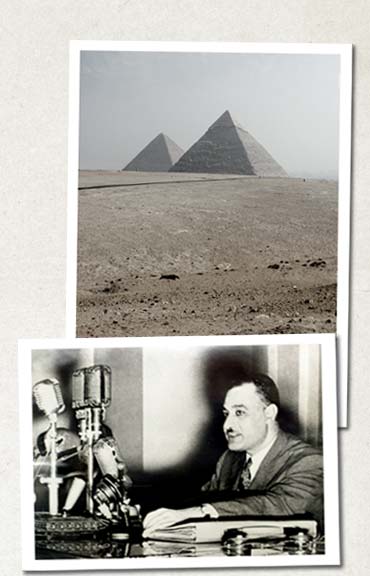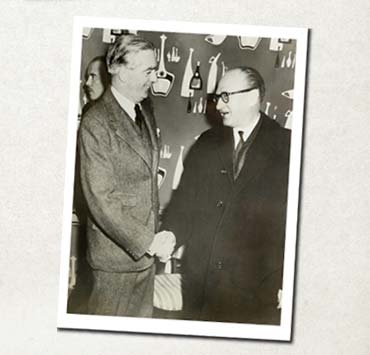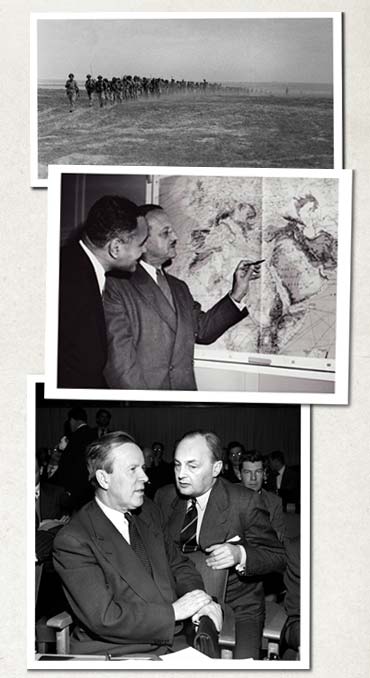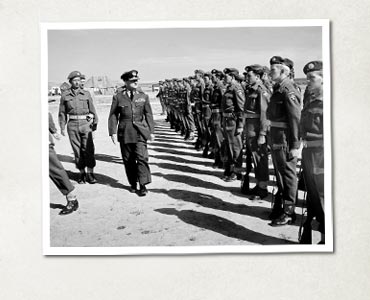
SUMMARY
|
|
The Suez Crisis erupts on July 26, 1956 when Egyptian President Abdul Nasser nationalises the Suez Canal Company – which had been run by the French with the British government as the largest single shareholder. Dubbed “the lifeline of Empire”, the Canal was an absolutely vital conduit for oil. If Nasser blocked the precious flow, he could cripple the British economy. Just as critical, Nasser’s dramatic gesture comes during the midst of the Cold War while Britain and France are struggling to maintain their influence in the Middle East and North Africa as well as their own sense of relevance. For British Prime Minister, Anthony Eden, the whole issue is an echo of his own struggle during the 1930s an d 1940s to confront Hitler and Mussolini. The British cabinet concedes in private that Nasser’s action is technically legal – especially as he claims he will reimburse the shareholders. But London and Paris both feel they cannot afford to suffer this insult to their pride and prestige. They immediately begin making plans for a military strike. This will take months to plan and conduct. In the meantime, Nasser runs the Canal like a business giving London and Paris no excuse to invade. As Canal traffic flows smoothly under Egyptian ownership, the initial public outrage fades and the widespread support for a military strike begins to evaporate. Eden decides he needs a pre-text to invade. Here the former diplomat and foreign secretary is trapped by his reputation as a “man of peace” and “United Nations man”. France is fighting a desperate guerrilla war in Algeria and sees Nasser as the dangerous embodiment of pan-Arab nationalism. The French government is keen to provide the British with their much sought after pre-text to invade Egypt and hopefully topple Nasser. So in October 1956, French officials arrange a piece of theatre with the newly created State of Israel, already an ally in the war against Nasser. Worried by the recent arms acquisitions in Egypt, seeking to build up credit with the Great Powers, Israel agrees to launch a major strike against Egypt. This will allow France and Britain to express their grave concern for peace and then land their own troops as “peacekeepers” to separate the Israeli and Egyptian armies. U.S. President Dwight Eisenhower is horrified by the steady lurch to war and repeatedly urges Eden to avoid force. But Eden refuses to back down. The Suez Crisis is arguably the worst break in U.S./U.K. relations in the 20th century. On the other side of the Atlantic Ocean, with no military, economic or geo-strategic interest in the Canal, Canada and therefore Lester Pearson is in a perfect position to carve out a middle ground between two extreme positions. But throughout the summer and fall of 1956, all his diplomatic efforts fail to change the course of British and French policy or halt the growing divide between Washington and London. Once Israel invades Egypt, Britain and France take on their guise as peacekeepers and begin bombing Egyptian positions. France and Britain are condemned at the United Nations. The Commonwealth splits along racial lines. The Western alliance is ripped apart. As the situation deteriorates, Pearson decided to propose the first UN peace-keeping force. Grasping at straws, his initial idea is to convert the invading French and British forces into real peacekeepers with a mandate from the UN. But the fury in the General Assembly and the rage from Washington will not allow this. Pearson abandons this stance and proposes a real UN force with no British or French forces. While the crisis is debated in the Security Council where Canada lacks a permanent seat, Pearson can play no direct role. Only when the debate is forcibly moved against the wishes of London and Paris to the General Assembly can the master diplomat play a front line role. Arriving at the Assembly on the evening of November 1st, Pearson and his delegation begin building a consensus for his proposal. Working closely with all parties across all divisions, Pearson puts together a coalition of support over 4 hectic sleepless days and nights. In the early hours of November 4th 1956, the General Assembly overwhelming supports Pearson’s proposal for the world’s first peacekeeping forces. Within two weeks, advance units arrive in Egypt. Bowing to international pressure and the arrival of UNEF, British and French forces complete their withdrawal from Egypt by the end of 1956. Israeli forces withdraw in the spring of 1957. UNEF will remain in Egypt until President Nasser expels it in 1967 on the eve of the 6 Day War with Israel. Praised at the UN for his brilliant efforts, Pearson is condemned by some at home for betraying the Mother Land. He tries to defend his record as one that actually tried to help Great Britain. Discontent with the Liberal government – in power for 22 years – leads to Prime Minister Louis St. Laurent losing the 1957 election. Removed from the world stage, Pearson now becomes a backbencher in Her Majesty’s Loyal Opposition. But in October 1957, on the opening of Parliament, he receives news that he has won the Nobel Peace Prize. In January of 1958, Pearson is chosen leader of the Liberal Party of Canada and eventually becomes Prime Minister in 1963 – but that is another story. |
     |
